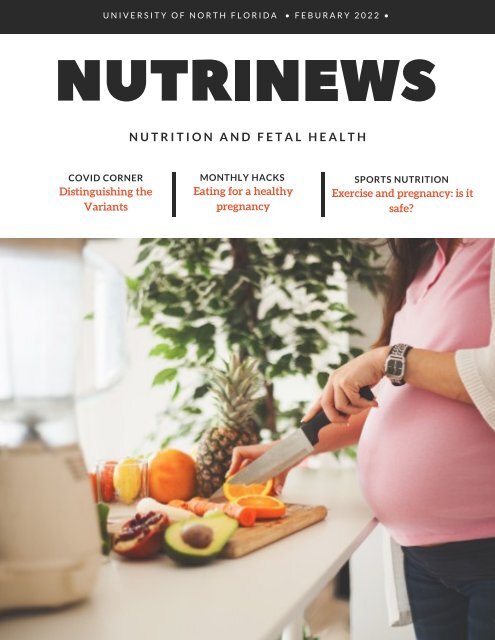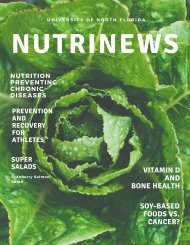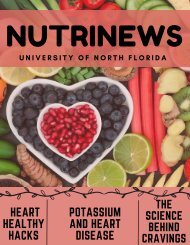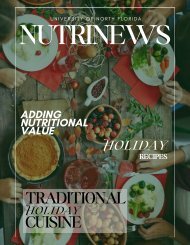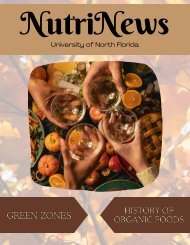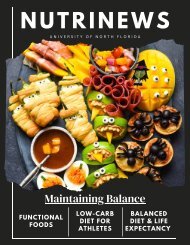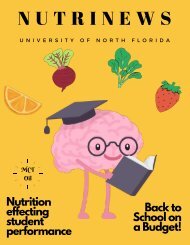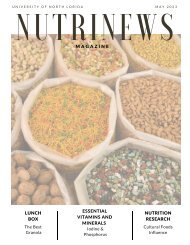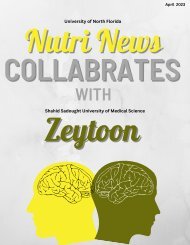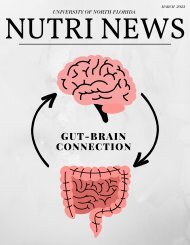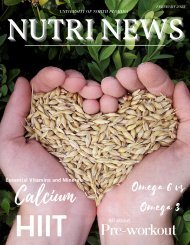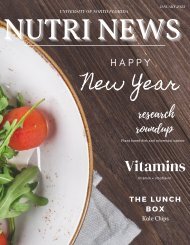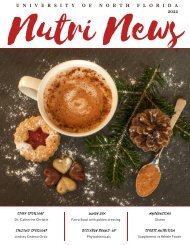NutriNews: Nutrition and Fetal Health
Hello all! The theme for February is Nutrition and fetal health. Topics include Nutrition research and tips for eating healthy during pregnancy. This month’s student spotlight is on our very own Robin Lee. I hope you all enjoy, learn, and get inspired by this month’s articles and recipes!
Hello all!
The theme for February is Nutrition and fetal health. Topics include Nutrition research and tips for eating healthy during pregnancy. This month’s student spotlight is on our very own Robin Lee.
I hope you all enjoy, learn, and get inspired by this month’s articles and recipes!
Create successful ePaper yourself
Turn your PDF publications into a flip-book with our unique Google optimized e-Paper software.
U N I V E R S I T Y O F N O R T H F L O R I D A<br />
• F E B U R A R Y 2 0 2 2 •<br />
N U T R I T I O N A N D F E T A L H E A L T H<br />
NUTRINEWS<br />
COVID CORNER<br />
Distinguishing the<br />
Variants<br />
MONTHLY HACKS<br />
Eating for a healthy<br />
pregnancy<br />
SPORTS NUTRITION<br />
Exercise <strong>and</strong> pregnancy: is it<br />
safe?
2<br />
COVID CORNER<br />
Distinguishing the Variants<br />
9<br />
RESEARCH<br />
ROUNDUP<br />
An interview with<br />
Mariana Marques.<br />
23<br />
NUTRITION<br />
RESEARCH<br />
What is <strong>Fetal</strong><br />
Programming? And<br />
What Does it Mean for<br />
Mothers?<br />
Table of Contents<br />
5<br />
MYTH-BUSTING<br />
Old Wives Tales Say: Eat<br />
This! But Definitely Don’t Eat<br />
That!<br />
12<br />
STUDENT<br />
SPOTLIGHT<br />
An interview with Robin<br />
Lee<br />
25<br />
THE LUNCH BOX<br />
Recipes aimed toward<br />
pregnant or lactating<br />
women<br />
8<br />
FOOD SCIENCE<br />
<strong>Nutrition</strong> & <strong>Fetal</strong> <strong>Health</strong><br />
17<br />
FACULTY SPOTLIGHT<br />
An interview with Dr.<br />
Ali<br />
28<br />
MONTHLY HACKS<br />
Eating for a healthy<br />
pregnancy<br />
32<br />
SPORTS<br />
NUTRITION<br />
Exercise <strong>and</strong><br />
pregnancy: is it safe?<br />
35<br />
NUTRINEWS<br />
STAFF<br />
Meet our staff!
2<br />
UNF COVID CORNER<br />
B Y : S O F I E V A N M O O R L E G H E M<br />
HAPPY FEBRUARY MY HEALTHY OSPREYS!<br />
We are officially back into the swing of the new year <strong>and</strong> new semester! By now, our school<br />
blues have been whisked away <strong>and</strong> we cannot wait till spring break <strong>and</strong> summer to be upon us.<br />
However, we cannot allow ourselves to relax just yet, even though we have the privilege of<br />
being back on campus for another semester, COVID-19 is still around <strong>and</strong> spreading. I am sure<br />
that many of you have heard about different terms like “variant,” “omicron,” <strong>and</strong> “mutation” as<br />
they are constantly broadcast on every news network. These can be confusing <strong>and</strong> often nervewracking<br />
as not much is known <strong>and</strong> information about the p<strong>and</strong>emic status is changing daily.<br />
Yet, as there is more than one variant spreading in the United States now, it is valuable to<br />
recognize the differences between Omicron, Delta, <strong>and</strong> the original COVID-19 virus.<br />
Distinguishing the Variants:<br />
Original COVID-19 Virus1:<br />
SARS-CoV-2 or the virus that causes COVID-<br />
19 is like every other virus <strong>and</strong> is always<br />
changing <strong>and</strong> mutating its genetic code.<br />
This is how new variants emerge, some<br />
variants do not make the cut <strong>and</strong> disappear,<br />
but sometimes they are strong enough <strong>and</strong><br />
will continue to spread, replacing previous<br />
variants. The most common misconception I<br />
see is the public believing there are only the<br />
two variants as that is the ones that the<br />
news is discussing.e public believing there<br />
are only the two variants as that is the ones<br />
that the news is discussing. However, there<br />
are about ten mutations of the virus, but<br />
some are just less strong or have the same<br />
transmissibility as the original virus, so it is<br />
no cause for concern. Only when there are<br />
breakthrough viruses, like delta <strong>and</strong><br />
omicron, they are mentioned in the news.To<br />
track <strong>and</strong> identify the differing SARS-CoV-2<br />
variants, the CDC1 uses genomic<br />
surveillance, which works to take the SARS-<br />
CoV-2 varieties for sequencing through the<br />
National SARS-CoV-2 Strain Surveillance<br />
(NS3) program where the virus’s genetic<br />
sequences are investigated <strong>and</strong><br />
distinguished as a particular variant. Using<br />
local <strong>and</strong> national labs, thous<strong>and</strong>s of<br />
sequences are examined every week<br />
through CDC’s national genomic sequencing<br />
<strong>and</strong> bioinformatics efforts to aid in<br />
identifying <strong>and</strong> monitoring the spread of the<br />
different variants.
3<br />
Delta 2:<br />
This variant was first identified in India <strong>and</strong><br />
when it was originally found, it was<br />
spreading more quickly <strong>and</strong> easily than the<br />
other variants causing more severe cases of<br />
infection. The vaccine is found to respond to<br />
this variant however there are breakthrough<br />
infections in people who are fully<br />
vaccinated. Yet, vaccines are necessary for<br />
preventing severe illness, hospitalizations,<br />
<strong>and</strong> death. Evidence found that fully<br />
vaccinated people infected with the Delta<br />
variant can still spread the virus to others<br />
<strong>and</strong> therefore it is still important to wear a<br />
mask <strong>and</strong> stay six feet apart. The delta<br />
variant is currently the most active form of<br />
the virus in the United States, but Omicron is<br />
becoming more active.<br />
Yet, breakthrough infections can happen, so<br />
it is important to stay alert, st<strong>and</strong> six feet<br />
apart, <strong>and</strong> wear a mask. The emergence of a<br />
new variant, like Omicron, just shows the<br />
importance of getting your vaccine <strong>and</strong><br />
further booster so we can finally stop the<br />
spread of COVID-19.<br />
UNF still expects everyone to get<br />
vaccinated, wear a mask on campus, <strong>and</strong><br />
stay home for 14 days if they feel any<br />
symptoms of COVID-19. Remember, we are<br />
all in this together <strong>and</strong> all count on each<br />
other in hopes of stopping the spread.<br />
Omicron3:<br />
The newest variant was first found in South<br />
Africa <strong>and</strong> has been found to spread faster<br />
<strong>and</strong> easier than other variants, including<br />
Delta. Not much is known in terms of severe<br />
illness <strong>and</strong> hospitalization by the CDC as the<br />
virus is still new <strong>and</strong> the effect of the variant<br />
is still being analyzed. However, similarly to<br />
the delta variant, the CDC currently expects<br />
that whether vaccinated or not, the Omicron<br />
variant can still be spread to others,<br />
although the current vaccines are still<br />
expected to protect against severe illness,<br />
hospitalizations, <strong>and</strong> deaths due to the virus.<br />
esources:<br />
1. CDC. COVID Data Tracker. Centers for Disease Control<br />
<strong>and</strong> Prevention. Published March 28, 2020.<br />
https://covid.cdc.gov/covid-data-tracker/#variantproportions<br />
2. CDC. Coronavirus Disease 2019 (COVID-19). Centers<br />
for Disease Control <strong>and</strong> Prevention. Published February<br />
11, 2020. https://www.cdc.gov/coronavirus/2019-<br />
ncov/variants/about-<br />
3. CDC. Coronavirus Disease 2019 (COVID-19). Centers for<br />
Disease Control <strong>and</strong> Prevention. Published February 11,<br />
2020.. https://www.cdc.gov/coronavirus/2019-<br />
ncov/variants/omicron-variant.html
B L A C K<br />
H I S T O R Y<br />
M O N T H<br />
F e b r u a r y<br />
4
Let's Celebrate February 1st!!<br />
NATIONAL<br />
FREEDOM<br />
DAY<br />
7
NUTRITION & FETAL HEALTH<br />
By: Samantha Dill<br />
Pregnancy <strong>and</strong> alcohol both involve bottles, but only<br />
one should be sipped from during gestation. Alcohol<br />
was recommended by doctors for pregnant women for<br />
pain relief as recently as the 1960s.1 However, the<br />
recognition of fetal alcohol syndrome (FAS) in 1973<br />
showed that consumption of alcohol during pregnancy<br />
can cause birth defects, such as facial deformities, in<br />
addition to stunted growth <strong>and</strong> development. In<br />
response to these findings, the Alcoholic Beverage<br />
Labeling Act was passed in 1988. The act stated that<br />
alcoholic beverages in the US must be labeled with a<br />
government warning that women should not consume<br />
alcohol during pregnancy due to an increased risk of<br />
birth defects.<br />
A political concern related to pregnancy occurred<br />
during World War II in Engl<strong>and</strong>. A declining population<br />
<strong>and</strong> rations encouraged the passing of the National<br />
Milk Scheme in Britain in 1940 to combat vitamin<br />
deficiency through free <strong>and</strong>/or discounted milk.3 The<br />
Vitamin Welfare Scheme was enacted shortly after <strong>and</strong><br />
distributed free <strong>and</strong>/or discounted orange juice <strong>and</strong><br />
cod liver oil. Maternal mortality declined shortly after.<br />
Nowadays, science has evolved more towards intake to fuel the body to support another being versus prioritizing<br />
pain relief for the host or basic nutritional needs. It has been recognized that women have greater energy needs<br />
during pregnancy. The recommended dietary intake for nutrients such as α-linolenic acid <strong>and</strong> thiamin for pregnant<br />
women is 25% higher than their nonpregnant counterparts, while protein <strong>and</strong> vitamin B6 needs are 50% higher.2<br />
Nutrient needs vary based on the stage of pregnancy due to the variety of functions nutrients have in tissue<br />
development <strong>and</strong> changes in maternal homeostasis. For instance, in the second <strong>and</strong> third trimesters, an additional<br />
340-450 kilocalories are needed to support fetal development. Energy needs during this time can also depend on<br />
other factors such as pre-pregnancy weight, activity level, <strong>and</strong> composition of weight gain. On average, a pregnant<br />
woman needs 85,000 additional calories during pregnancy; this is the equivalent of 300 added calories daily. Overall,<br />
it is important to note that the mother is eating for two.<br />
REFERENCES<br />
1. GUNTER, J. DRINKING WHILE PREGNANT: AN INCONVENIENT TRUTH. THE NEW YORK TIMES WEBSITE. HTTPS://WWW.NYTIMES.COM/2019/02/05/STYLE/DRINKING-WHILE-<br />
PREGNANT.HTML. PUBLISHED FEBRUARY 5, 2019.<br />
2. LAMMI-KEEFE CJ, COUCH SC, PHILIPSON EH. HANDBOOK OF NUTRITION AND PREGNANCY. HUMANA PRESS; 2008. DOI:10.1007/978-1-59745-112-3.<br />
3. SULTAN N. DIET IN PREGNANCY, 1930–1960: A SHIFTING SOCIAL, POLITICAL AND SCIENTIFIC CONCERN. MEDICAL HUMANITIES. 2010;36(2):118-15. DOI:10.1136/JMH.2010.005496.<br />
8
RESEARCH<br />
Written by Laura Rogers<br />
ROUNDUP<br />
With many professors on campus conducting<br />
research comes a great need for research<br />
assistants. Therefore, it is beneficial quite a few<br />
graduate degrees have research requirements.<br />
Also, with increasing educational dem<strong>and</strong>s of<br />
several fields warrants undergrads to obtain<br />
research experience prior to grad school.<br />
However, for the experience to be of quality<br />
deems the student’s passions to be aligned<br />
with the study conducted; simply checking the<br />
box off a list of requirements will not be of<br />
significant benefit to anyone involved.<br />
Mariana Marques was interviewed to get the<br />
inside scoop of UNF research from a student’s<br />
perspective:<br />
Tell me a little bit about yourself.<br />
By 2002, over 21 million Type 1s had been<br />
produced, but by 2003, annual production had<br />
dropped to 30,000 from a peak of 1.3 million in<br />
1971. VW announced the end of production in<br />
June 2003, citing decreasing dem<strong>and</strong>, <strong>and</strong> the final<br />
original Type 1 VW Beetle (No. 21,529,464) rolled<br />
off the production line at Puebla, Mexico, on 30<br />
July 2003.<br />
9
What type of research are you involved in?<br />
I am currently a graduate assistant at the<br />
University <strong>and</strong> working under the supervision of<br />
Dr. Kerry Clark. The focus of his research is on<br />
Ticks <strong>and</strong> Tick-borne diseases.<br />
What are your roles within the research<br />
team?<br />
I am responsible for assisting Dr. Clark with<br />
setting up PCR tests, which basically help amplify<br />
DNA of pathogens in samples. Besides that, I also<br />
help with basic laboratory duties, such as making<br />
gels for the electrophoresis procedures, mixing<br />
primers for the PCR tests, <strong>and</strong> so on.<br />
What are the measurable parameters of<br />
this work?<br />
Through this work, we are able to identify<br />
geographic locations where tick borne diseases<br />
might be prevalent. We can also match DNA<br />
sequences to identify which pathogens are being<br />
carried <strong>and</strong> which ones are not.<br />
What are the anticipated outcomes/what<br />
are the main goals of this study?<br />
The main goals/outcomes of this study are to<br />
obtain evidence of the presence <strong>and</strong> magnitude of<br />
tick-borne diseases in Florida <strong>and</strong> other<br />
surrounding states. Dr. Clark was the first to<br />
identify Lyme disease in lizards both in Florida <strong>and</strong><br />
South Carolina. He also happens to be the first to<br />
identify Borrelia species infections in Lyme<br />
patients in the US. His contributions to the field of<br />
environmental health are really unmatched.<br />
What has been the highlight of this<br />
experience overall?<br />
Graduate assistantship opportunities are<br />
invaluable to anyone who wishes to pursue a<br />
career in research <strong>and</strong> academia. I was also lucky<br />
enough to be paired with someone who inspires<br />
me <strong>and</strong> whose work I admire. Being able to learn<br />
so much while also making significant<br />
contributions to this work has definitely been the<br />
highlight of my experience.<br />
10
Did you have any research experience<br />
during your undergrad?<br />
During my undergraduate years, I acquired<br />
laboratory techniques knowledge that help me<br />
perform everyday work, but I did not have any<br />
previous research experience. Graduate<br />
assistantship positions are definitely attainable<br />
even with no previous experience so long as you<br />
are able to show you interests, how you would<br />
benefit from being a graduate assistant, <strong>and</strong> how<br />
you'd be able to contribute, not only to the faculty<br />
members but to the department as a whole.<br />
Do you have any advice for those pursuing<br />
graduate-level research?<br />
Graduate level research is as challenging as it is<br />
rewarding. Spots are very limited so to anyone<br />
who is interested in becoming a graduate<br />
assistant, I would suggest connecting with faculty<br />
members whose work lines up with your interests<br />
<strong>and</strong> applying in advance. Make sure your<br />
application is strong <strong>and</strong> highlights your potential.<br />
It is also important to have good grades <strong>and</strong> good<br />
overall academic performance. Some sort of<br />
previous experience such as tutoring, academic<br />
coaching, or even a Bachelor of Science degree for<br />
those who wish to follow the research path might<br />
be helpful as well.<br />
11
Student Spotlight:<br />
Robin Lee<br />
<br />
By: Carol Egan<br />
Welcome to February, where the Valentine’s<br />
Day chocolates are just as rich as our country’s<br />
history! This month, our Student in the Spotlight<br />
is Robin Lee, a Jacksonville native <strong>and</strong> a senior<br />
in the UNF <strong>Nutrition</strong> <strong>and</strong> Dietetics program.<br />
Robin is a busy mom of five beautiful children, 4<br />
of which are two sets of twins! She currently<br />
works as a substitute teacher for Duval County<br />
schools, <strong>and</strong> she enjoys painting, exercising,<br />
reading, <strong>and</strong> going on walks to be with nature.<br />
Read further to learn more about this ambitious<br />
mother, teacher, <strong>and</strong> student!<br />
CE: When did you know you wanted to pursue a<br />
degree in dietetics? What influenced you?<br />
RL: In 2014, I decided to take back my health<br />
after being told by my physician that my blood<br />
pressure was high <strong>and</strong> he began to ask me<br />
questions about my lifestyle <strong>and</strong> any changes in<br />
my diet since my last appointment. He asked me<br />
specifically about my diet <strong>and</strong> pointed out things<br />
that needed to change. So, I started to dig deep<br />
<strong>and</strong> learn everything about food to get me healthy<br />
again. I also started working out at the gym <strong>and</strong><br />
got my pressure down <strong>and</strong>, over time, people<br />
would approach me about my workout regimen<br />
<strong>and</strong> my diet. I found it easy to speak about<br />
workouts but struggled with giving advice for<br />
their diets without being properly educated <strong>and</strong><br />
chose to pursue a degree in dietetics. I am<br />
passionate about educating <strong>and</strong> empowering<br />
others to also take back their health.<br />
12
CE: What has been your favorite class through the<br />
degree program? Why?<br />
RL: My favorite class in this degree program was<br />
Management of Food <strong>and</strong> <strong>Nutrition</strong> Services<br />
courses I <strong>and</strong> II. This course allowed me to see all<br />
the possibilities that having a degree in dietetics<br />
can offer. We covered so much material in the<br />
course from learning about operational task of<br />
foodservice, h<strong>and</strong>s on experience through<br />
volunteer work, school cafeterias, restaurant<br />
management, personality traits, food resourcing,<br />
ServSafe licensure <strong>and</strong> coming up with<br />
entrepreneurship ideas in the food industry. It<br />
didn’t cover all things learned but this course was<br />
so informative <strong>and</strong> fulfilling in every way.<br />
CE: What has challenged you most during your<br />
time as a student at UNF?<br />
RL: My last two semesters have been the most<br />
challenging as a student. There have been many<br />
changes that were not planned in my life at the<br />
start of my matriculation at UNF so these changes<br />
have caused some added stress but my faith has<br />
sustained me <strong>and</strong> I’m moving forward.<br />
Challenging times are temporary, but personal<br />
growth is the reward once you have gone through<br />
them.<br />
CE: Do you have any advice for students entering<br />
the Dietetics Program?<br />
RL: I would tell anyone entering the dietetics<br />
program that this degree offers a variety of career<br />
paths in areas ranging from clinical dietetics to<br />
public health or food manufacturing <strong>and</strong> the list<br />
goes on. Because of all the choices available it can<br />
seem overwhelming at first but start with<br />
volunteer work in the areas offered within the<br />
nutrition <strong>and</strong> dietetics degree. This will not only<br />
help to build your resume, but you also gain a<br />
perspective on the field that can help to fine tune<br />
your interests<br />
CE: What is your favorite thing to do in your free<br />
time outside of school?<br />
RL: As a mother of five, it is often hard to find that<br />
free time. But when I do, I’m either taking care of<br />
my many plants, reading a book, painting, or<br />
hitting the nature trail with my kids<br />
13
<strong>and</strong> our dog, Chopper. I find that tending to all<br />
things nature awakens your mind, helps you to<br />
connect to your roots <strong>and</strong> is very healing. I love it<br />
out there!<br />
CE: Do you have a favorite club or volunteer<br />
activity in relationship with UNF? If so, what is it,<br />
<strong>and</strong> why do you enjoy it?<br />
RL: I had the opportunity to volunteer at the<br />
Sulzbacher Center in relation to the Food<br />
Management course at UNF. The Sulzbacher<br />
Center is a homeless center that provides<br />
outreach, daily meals, emergency housing, case<br />
management support, veteran services, job<br />
placement assistance, as well as permanent<br />
supportive housing. There, I had the pleasure to<br />
serve our homeless community hot <strong>and</strong> nutritious<br />
meals. This experience helped to solidify my love<br />
for serving others <strong>and</strong> I hope to return soon.<br />
CE: As a dietitian, you will have a lot of options for<br />
career paths. What career path is most exciting to<br />
you <strong>and</strong> why?<br />
RL: The career path that is most rewarding for me<br />
would be in public health. Pursuing a career in<br />
public health as a nutritionist, I will have the<br />
ability to influence decisions <strong>and</strong> policies that can<br />
impact lives in a positive way for my community.<br />
CE: Do you keep any quotes or sayings in the back<br />
of your mind to keep you motivated every day? If<br />
so, what is it <strong>and</strong> how does it help you?<br />
RL: “If you believe it’ll work out, you’ll see<br />
opportunities. If you don’t believe it’ll work out,<br />
you’ll see obstacles.” –Wayne Dyer.<br />
“Remember, I comm<strong>and</strong>ed you to be strong <strong>and</strong><br />
brave. Don’t be afraid, because the Lord your God<br />
will be with you wherever you go.” –Joshua 1:9<br />
ERV<br />
Robin’s thoughts on Black History Month<br />
RL: Over the holidays I attended a family reunion<br />
<strong>and</strong> my older family members who grew up in the<br />
sixties here in Jacksonville were asked about<br />
some of the history they remembered during the<br />
time of segregation. My uncle <strong>and</strong> my dad<br />
mentioned a vicious attack on black protestors<br />
called Ax H<strong>and</strong>le Saturday. We all listened<br />
attentively as they spoke of the horrors of that<br />
day. My uncle said he was working at a barber<br />
shop nearby when someone rushed in <strong>and</strong> said<br />
there’s a riot in Hemming Park. On what is called<br />
Ax H<strong>and</strong>le Saturday, 200 KKK members attacked<br />
African American demonstrators who were<br />
participating in a sit-in at the whites-only<br />
Woolworth lunch counter in downtown<br />
Jacksonville. The protest was to opposed racial<br />
segregation. This event happened on August 27,<br />
1960 <strong>and</strong> the reason it’s called Ax is because the<br />
Klansmen were given Ax h<strong>and</strong>les<br />
14
to threaten <strong>and</strong> use against African<br />
American protesters that day. As I<br />
reflect on the fights to end segregation<br />
<strong>and</strong> how my ancestors didn’t budge<br />
that day, they showed so much<br />
strength <strong>and</strong> courage. I’m here today<br />
because of that courage <strong>and</strong> I’ll be<br />
forever grateful for all who pushed<br />
past fear, for pushing past the fear you<br />
gain confidence, empowerment, <strong>and</strong><br />
growth. “Take the first step in faith.<br />
You don’t have to see the whole<br />
staircase, just take the first step.” –<br />
Martin Luther King Jr.<br />
Robin’s Rapid-Fire Questions:<br />
Favorite color? Navy blue<br />
Favorite food? Lasagna<br />
Favorite place? Any nature trails<br />
Biggest fear? Nothing to fear but fear itself<br />
Favorite movie? The Color Purple<br />
Favorite book? The Four Agreements by Don<br />
Miguel Ruiz<br />
Favorite song? Outside by Mariah Carey<br />
15
16<br />
3<br />
FEB<br />
NATIONAL<br />
W O M E N<br />
P H Y S I C I A N S<br />
D A Y
Faculty Spotlight:<br />
<br />
Dr. Alireza Jahan-Mihan<br />
By: Anna Waterman<br />
This month we are highlighting Dr. Alireza<br />
Jahan-Mihan, or as many of us know him, Dr.<br />
Ali. Dr. Ali grew up in Iran <strong>and</strong> that is where his<br />
career in nutrition began. He graduated as the<br />
first nutrition cohort from the Shiraz University<br />
of Medical Sciences <strong>and</strong> began working in a<br />
general hospital to gain experience <strong>and</strong><br />
knowledge. Here, he spearheaded a project to<br />
tailor tube feedings for the specific needs of the<br />
patients. From working as a clinical dietitian in<br />
the food industry to private practice, Dr. Ali has<br />
done it all. After immigrating to Canada in 2002,<br />
he refocused on completing his Ph.D. at the<br />
University of Toronto <strong>and</strong> found a new passion<br />
for nutrition research.<br />
While he was working on his Ph.D. research<br />
project, he obtained his RD credential in Canada<br />
<strong>and</strong> worked as a dietitian simultaneously.<br />
Although the research projects in Canada were<br />
exciting, the weather was less than desirable. So,<br />
in 2013, Dr. Ali agreed to interview for a faculty<br />
position here at UNF. Once here, he instantly fell<br />
in love with the faculty, the facility, <strong>and</strong> the<br />
students. Since being here, he has not only<br />
published more research with many global<br />
collaborators, but he also sparked the idea for the<br />
<strong>Nutrition</strong> Journal Club as well as the magazine<br />
you are reading now, UNF<strong>NutriNews</strong>. Read on to<br />
be further inspired by one of our amazing<br />
nutrition professors.<br />
17
First some thoughts on UNF<strong>NutriNews</strong> from Dr. Ali:<br />
When the magazine was first launched in 2015, some did not believe it would be doable to<br />
publish monthly, but Dr. Ali was confident in the students at UNF <strong>and</strong> believed in their drive<br />
<strong>and</strong> determination. “The main engine of the department is not us [faculty], it is the students.”<br />
We can lead <strong>and</strong> share our experience, but they will decide which direction to go.<br />
UNF<strong>NutriNews</strong> is a dynamic experience that offers a lot of benefits to the staff. “It’s not just<br />
about publishing an issue, it’s about the process. It’s learning how to work as a team, how to<br />
be a leader.”<br />
AW: What was the focus of your nutrition<br />
research prior to coming to UNF?<br />
Dr. Ali: When working on research in Iran, Dr. Ali<br />
was inspired to study GI cancer due to the<br />
diagnosis of his academic supervisor with this<br />
disease. This research focused on how nutrition<br />
education can influence the total well-being of GI<br />
cancer patients.<br />
The University of Toronto is a research-based<br />
university, so Dr. Ali worked with Dr. Harvey<br />
Anderson on many research projects here<br />
alongside very prominent members of the<br />
nutrition research community, Dr. Thomas<br />
Wolever <strong>and</strong> Dr. David Jenkins who are famously<br />
known for developing the glycemic index.<br />
While here, the focus of Dr. Ali’s research was<br />
proteins. First, it started with how different<br />
sources of protein influence body weight <strong>and</strong><br />
body composition. Then, the research evolved<br />
into how dietary proteins consumed during<br />
pregnancy <strong>and</strong> lactation can influence the risk of<br />
the development of hypertension, diabetes,<br />
obesity, <strong>and</strong> other components of metabolic<br />
syndrome. Essentially, the mother’s nutrition can<br />
“program” the fetus to be less or more vulnerable<br />
to obesity <strong>and</strong> certain diseases.<br />
I am also working on the role of nutrition in<br />
physical performance. In collaboration with<br />
CAMS, we studied the effect of intensity of<br />
exercise on food intake regulation. More studies<br />
in this area are on my agenda.<br />
18
AW: Can you tell us more about fetal<br />
programming?<br />
Dr. Ali: It is a fairly new field of research<br />
that has only been around for about 15<br />
years. It is important because it can help us<br />
underst<strong>and</strong> why some may develop chronic<br />
diseases or obesity even when lifestyle<br />
factors are not contributing. While some<br />
point to genetics in these cases, it is likely<br />
that it is epigenetic. Epigenetic means<br />
whatever happens during pregnancy <strong>and</strong><br />
lactation <strong>and</strong> up to two years after birth<br />
can influence health status for the rest of<br />
our lives. During this time, fetal organs are<br />
in the “stage of plasticity” which means<br />
they are open to influence from the<br />
environment. One of the largest influences<br />
on fetal programming is maternal diet <strong>and</strong><br />
it’s not just about deficiency. Even in<br />
nutritionally adequate diets, different<br />
sources of protein may influence <strong>and</strong><br />
program the fetus in various ways. It is not<br />
enough to recommend an “adequate <strong>and</strong><br />
balanced diet” during pregnancy because<br />
the presence of various macronutrients<br />
<strong>and</strong> micronutrients will play a role in fetal<br />
programming.<br />
For example, although soy protein <strong>and</strong><br />
casein protein are both nutritionally good<br />
proteins, biologically <strong>and</strong> physiologically,<br />
they are different. Their function is<br />
different, their effect on protein synthesis<br />
is different, their effect on the development<br />
of the blood pressure regulating system is<br />
different as is their effect on the<br />
hypothalamus. Body composition, body<br />
weight, <strong>and</strong> food intake are all regulated by<br />
the hypothalamus, so if a certain portion of<br />
the diet can influence the development of<br />
certain areas of the body to a high degree,<br />
then the fetus will be programmed in a<br />
different way.<br />
AW: How is this research being<br />
conducted?<br />
Dr. Ali: This research has been conducted<br />
using rats because we cannot do these<br />
types of studies in humans. It’s very<br />
difficult to follow participants in a study<br />
from pregnancy to teenage years. In rats,<br />
the entire pregnancy is only 3 weeks,<br />
lactation is 3 weeks, <strong>and</strong> the offspring are<br />
completely mature in 12 weeks. So,<br />
everything can be completed in about 24<br />
weeks.<br />
In terms of applicability, rats are 89%<br />
genetically similar to humans. When you<br />
open the abdominal area <strong>and</strong> chest, it is<br />
identical to humans except that it is<br />
smaller. The main difference between<br />
humans <strong>and</strong> rats is our brain, but other<br />
organs are essentially the same. They also<br />
contain all the same hormones, insulin<br />
<strong>and</strong> ghrelin with the same functions; even<br />
the normal blood pressure level is the<br />
same, blood glucose is the same, <strong>and</strong> the<br />
definition of diabetes is the same.<br />
While animal studies may not be respected<br />
as much in the dietetics community, 80%<br />
of our knowledge comes from these<br />
studies because many times we cannot use<br />
human subjects either for ethical reasons<br />
or simple time constraints.<br />
19
AW: Lastly, could you offer some advice<br />
for students pursuing a degree in<br />
dietetics?<br />
Dr. Ali: The main point is that it is about<br />
you, not just filling the hours <strong>and</strong> making<br />
your boss happy. In any job, you can do<br />
the minimum <strong>and</strong> just pass the time, but<br />
instead, see it as an opportunity. Wherever<br />
you are going, whatever you are doing,<br />
think about how you can make a positive<br />
change in that environment. Whatever<br />
you are doing, it will be your signature<br />
<strong>and</strong> you want to have a good signature.<br />
If you like dietetics, do it. If you don’t,<br />
don’t waste your time because it will be<br />
torture for yourself, <strong>and</strong> you won’t be<br />
useful to others. You must move beyond<br />
just being a laborer <strong>and</strong> just doing a job to<br />
survive. You must be creative, you must<br />
own your work, you have to challenge<br />
yourself, <strong>and</strong> make a change in your<br />
environment if you want to be satisfied<br />
with your work.<br />
If you are interested in learning more about Dr. Ali’s research you can simply type “Jahan<br />
mihan” in Google Scholar. Here are some selected articles highlighting his research as<br />
follows:<br />
1. Jahan-mihan A; Magyari P; Pinkstaff S. The Effect of Intensity of Exercise on Appetite <strong>and</strong><br />
Food Intake Regulation in Post-Exercise Period (A R<strong>and</strong>omized Trial): Journal of <strong>Nutrition</strong><br />
<strong>and</strong> Exercise.2021, 4 (3): 12.<br />
2. Jahan-Mihan A, Rodriguez J, Christie C, Sadeghi M, Zerbe T. The Role of Maternal Dietary<br />
Proteins in Development of Metabolic Syndrome in Offspring. Nutrients. 2015; 7(11): 9185-<br />
217. Doi: https://doi.org/10.3390/nu7115460<br />
3. Jahan-Mihan A. The Effect of Maternal Intact Protein- <strong>and</strong> Amino Acid-Based Diets on<br />
Development of Food Intake Regulatory Systems <strong>and</strong> Body Weight in Dams <strong>and</strong> Male<br />
Offspring of Wistar Rats. Int J Mol Sci. 2019; 20(7):1690. Doi:<br />
https://doi.org/10.3390/ijms20071690<br />
20
21
22
U T R I T I O N R E S E A R C H :<br />
N<br />
H A T I S F E T A L P R O G R A M M I N G ? A N D W H A T D O E S I T<br />
W<br />
programming may sound intimidating, but it is really<br />
<strong>Fetal</strong><br />
the theory that different environmental cues<br />
just<br />
throughout the course of fetal development<br />
experienced<br />
a role in determining the health trajectories of the<br />
play<br />
throughout the rest of their life.1 In other words, the<br />
fetus<br />
status of the mother throughout pregnancy will<br />
nutritional<br />
the health of the fetus <strong>and</strong> therefore the child<br />
influence<br />
the rest of its life. It is well known that nutrition during<br />
for<br />
is one of the most important factors in the<br />
pregnancy<br />
of the fetus. For example, nutrition directly<br />
development<br />
the development of endocrine systems,<br />
influences<br />
mechanisms, <strong>and</strong> somatic structures in the<br />
homeostatic<br />
<strong>and</strong> infant—<strong>and</strong> these effects can influence the risk<br />
fetus<br />
developing chronic disease like obesity, cancer,<br />
of<br />
undernutrition in particular can be devastating<br />
<strong>Fetal</strong><br />
the fetus. Undernourishment of the fetus can lead<br />
to<br />
metabolic dependence on glucose to decrease or<br />
to<br />
the oxidation of other substrates, as the<br />
increase<br />
metabolic response of the fetus is to<br />
immediate<br />
its own substrate to produce energy through<br />
consume<br />
Extended malnutrition can lead to<br />
catabolism.1<br />
growth in the fetus <strong>and</strong> it is hypothesized that<br />
delayed<br />
process of storing glucose continues into<br />
the<br />
which can lead to insulin resistance.1<br />
adulthood,<br />
growth can influence the fetus to try <strong>and</strong><br />
Delayed<br />
tissues (especially brain tissue), which can<br />
protect<br />
to tissue loss in the liver <strong>and</strong> other abdominal<br />
lead<br />
tissue.1<br />
visceral<br />
M E A N F O R M O T H E R S<br />
By: Haley Brock<br />
diabetes, <strong>and</strong> hypertension later in life.2<br />
23
the other end of the spectrum, there is the case of maternal obesity or<br />
On<br />
diabetes during pregnancy, which can increase the risk of<br />
gestational<br />
<strong>and</strong>/or glucose intolerance in offspring.2 Gestational diabetes has<br />
obesity<br />
linked to a higher risk of obesity in later life, <strong>and</strong> intrauterine exposure<br />
been<br />
maternal obesity has been linked with an increased risk of metabolic<br />
to<br />
<strong>and</strong> obesity later in life.2<br />
syndrome<br />
<br />
<br />
the protein source a mother chooses can have an affect on their fetus!<br />
Even<br />
<strong>and</strong> soy-protein based diets during pregnancy have been shown to<br />
Casein-<br />
different effects on the development of metabolic syndrome in rats<br />
have<br />
their offspring.2 A soy-protein diet has been associated with higher<br />
<strong>and</strong><br />
plasma glucose <strong>and</strong> insulin levels than a casein-protein diet.2 In<br />
fasting<br />
higher systolic <strong>and</strong> diastolic blood pressure readings have been<br />
addition,<br />
in rat offspring whose mothers consumed mostly soy protein.2<br />
found<br />
<br />
these studies on fetal programming have shown is that while nutrition<br />
What<br />
important at all aspects of life, it might be most important during<br />
is<br />
O U R C E S :<br />
S<br />
<br />
. K W O N E J , K I M Y J . W H A T I S F E T A L P R O G R A M M I N G ? : A L I F E T I M E H E A L T H I S U N D E R T H E C O N T R O L O F<br />
1<br />
N U T E R O H E A L T H . O B S T E T G Y N E C O L S C I . 2 0 1 7 ; 6 0 ( 6 ) : 5 0 6 - 5 1 9 . D O I : 1 0 . 5 4 6 8 / O G S . 2 0 1 7 . 6 0 . 6 . 5 0 6 .<br />
I<br />
<br />
. J A H A N - M I H A N A R . D I E T A R Y P R O T E I N S , D E V E L O P M E N T A L P R O G R A M M I N G , A N D P O T E N T I A L<br />
2<br />
<br />
pregnancy.<br />
<br />
M P L I C A T I O N I N M A T E R N A L O B E S I T Y . J O U R N A L O F N U T R I T I O N A N D F O O D S E C U R I T Y . 2 0 1 7 ; 2 ( 3 ) : 2 3 5 -<br />
I<br />
2 . H T T P S : / / J N F S . S S U . A C . I R / B R O W S E . P H P ? A _ I D = 8 7 & S L C _ L A N G = E N & S I D = 1 & F T X T = 1 & H T M L =<br />
4<br />
24
T H E L U N C H B O X<br />
B Y : P A I G E C O U R T I E R<br />
B R E A K F A S T I D E A F O R P R E G N A N T W O M E N<br />
S P I N A C H , Z U C C H I N I , A N D L E E K F R I T T A T A W I T H R O A S T E D B U T T E R N U T S Q U A S H<br />
S P I N A C H , Z U C C H I N I , A N D L E E K F R I T T A T A :<br />
Frittata Ingredients<br />
· 1 tbsp olive oil<br />
· 1 tbsp butter<br />
· ½ cup finely chopped<br />
zucchini<br />
· 1 cup of thinly sliced leek<br />
(only white <strong>and</strong> light green<br />
portion)<br />
· 1 cup chopped spinach<br />
· 1 minced clove of garlic<br />
· 1/3 cup feta cheese<br />
· 3 whole eggs<br />
· 3 egg whites<br />
· 2 tbsp mil<br />
Instructions for the Frittata<br />
1) Preheat oven to 350 F. Grease an 8-inch casserole or pie dish;<br />
set aside.<br />
2) On medium heat, heat butter <strong>and</strong> olive oil in a non-stick<br />
skillet.<br />
3) Add sliced leek <strong>and</strong> chopped zucchini <strong>and</strong> reduce to<br />
medium-low. Cook for 10-12 minutes, stirring often.<br />
4) Add spinach <strong>and</strong> garlic, cook for 2-3 minutes. Stir in salt,<br />
pepper, <strong>and</strong> fresh parsley. Remove skillet from heat.<br />
5) Whisk the eggs, egg whites, <strong>and</strong> milk in a bowl <strong>and</strong> pour into<br />
vegetable mixture. Combine well.<br />
6) Transfer egg <strong>and</strong> vegetable mixture to greased 8-inch<br />
casserole or pie dish.<br />
7) Bake at 350 F for 25 minutes <strong>and</strong> broil for 2-3 minutes (or until<br />
top is lightly browned).<br />
8) Let cool <strong>and</strong> enjoy<br />
25
2018<br />
STATISTICS<br />
Infant <strong>and</strong> Maternal<br />
Mortality in African<br />
Americans<br />
Infant Deaths:<br />
10.8 out of 1,000 live births<br />
<br />
Top 5 Leading Causes of death for African Americans<br />
Low Birth Weight (247.5 per 100,000)<br />
Congenital Malformations (156.9 per 100,000)<br />
Maternal Complications (77.7 per 100,000)<br />
Sudden Infant Death Syndrome (SIDS) (69.6 per<br />
100,000)<br />
Accidents (unintentional injuries (58 per<br />
100,000)<br />
African American are three to four times more<br />
likely to experience pregnancy related death<br />
than white women.<br />
For more resources on tackling infant <strong>and</strong> maternal mortalities in African Americans visit<br />
https://www.cdc.gov/healthequity/features/maternal-mortality/index.html<br />
https://www.nationalpartnership.org/our-work/health/reports/black-womens-maternal-health.html<br />
https://minorityhealth.hhs.gov/<br />
27
31
Sports <strong>Nutrition</strong><br />
Exercise <strong>and</strong> pregnancy: is it safe?<br />
BY: BRIANNA BRAND<br />
Anyone pregnant can attest to this; as soon as you are noticeably pregnant, every<br />
choice you make is heavily scrutinized, <strong>and</strong> unwarranted advice is plentiful. I often<br />
see this when pregnant women are exercising in a public place because there are<br />
misconceptions on updated safe pregnancy recommendations due to continuously<br />
evolving research. What used to be conservative exercise recommendations has<br />
turned much more relaxed <strong>and</strong> even encouraged because the good outweighs the<br />
bad under normal circumstances. Generally, if a woman is exercising regularly<br />
before her pregnancy, she is safe to continue doing so.1Although, regardless of<br />
whether a woman is active pre-pregnancy or wants to start exercising during her<br />
pregnancy, they should check with their doctor to ensure it is safe for themselves<br />
<strong>and</strong> the development of the baby.1,2 In table 1, provided by Schoenfeld, there are<br />
conditions listed in which it is best to restrict exercise.2<br />
Schoenfeld B. Resistance training during pregnancy: safe <strong>and</strong> effective program design. Strength & Conditioning Journal.<br />
2011;33(5):67–75. doi:10.1519/SSC.0b013e31822ec2d8<br />
32
If none of these risks are present <strong>and</strong> the woman is cleared by her doctor to<br />
exercise during pregnancy, women should still take certain precautions while<br />
exercising to maximize safety. One of the risks those who are pregnant should be<br />
wary of is hypoxia; when exercising, extra blood is pumped to the muscles being<br />
worked; when this happens during pregnancy, blood flow to the uterus is<br />
decreased, which may result in inadequate fetal oxygen supply. 1 In those that are<br />
conditioned, this is less likely to happen. The risk of blood pooling can be<br />
decreased by involving the whole body in exercising; this is naturally occurring in<br />
walking, running, <strong>and</strong> swimming.2 In women participating in resistance training,<br />
Schoenfeld has successfully implemented every other-day full-body training with an<br />
emphasis on isometric core training.2 Research shows that 76% of women will<br />
report low back pain at some point in their pregnancy due to an altered center of<br />
gravity leading to increased lumbar curvature.2 It is shown that women who<br />
strengthen their core can significantly reduce their lower back pain <strong>and</strong> may even<br />
experience shorter <strong>and</strong> easier labor.1,2 To make room for the growing fetus, the<br />
joints become laxer; because of this, Schoenfeld recommends higher rep ranges to<br />
decrease stress on the joint <strong>and</strong> chance of injury.2<br />
It is also essential that the mother rests a minimum of 2 minutes in between to<br />
allow for heart rate restoration in between sets. Breathing <strong>and</strong> heart rate must be<br />
monitored during activity. A great way to test this is the talk test; If the pregnant<br />
person cannot hold a conversation while exercising, is it a sign that her heart rate<br />
is getting too high <strong>and</strong> that she should rest.1 While pregnant, exercise should not<br />
be taken to exhaustion or failure, <strong>and</strong> women should be wary of becoming<br />
overheated, avoiding saunas <strong>and</strong> hot tubs.1<br />
Schoenfeld B. Resistance training during pregnancy: safe <strong>and</strong> effective program design. Strength & Conditioning Journal.<br />
2011;33(5):67–75. doi:10.1519/SSC.0b013e31822ec2d8<br />
33
Despite some of the risks present, the potential benefits make exercising during pregnancy worth<br />
trying. As mentioned previously, working out can result in a more comfortable pregnancy <strong>and</strong> make<br />
labor easier. Staying active may also decrease risk factors associated with pregnancy. For example,<br />
studies show that a regular exercise regimen can reduce the risk of gestational diabetes by 59%<br />
<strong>and</strong> preeclampsia by 24-54%, with the decrease in risk increasing with exercise intensity.2 Working<br />
out may also improve mental health <strong>and</strong> confidence during <strong>and</strong> after pregnancy, as it does for nonpregnant<br />
people. These benefits may last even after birthing; in an observational study, researchers<br />
found that children of mothers who were active throughout their pregnancy had a more developed<br />
nervous system <strong>and</strong> showed to be more focused <strong>and</strong> disciplined. These are just some of the few<br />
benefits someone may experience if they have an active pregnancy, as long as they are medically<br />
cleared for exercise <strong>and</strong> follow prescribed safety measures.<br />
References: 1. Jarski RW, Trippett DL. The risks <strong>and</strong> benefits of exercise during pregnancy. J Fam Pract.<br />
1990;30(2):185-189. 2. Schoenfeld B. Resistance training during pregnancy: safe <strong>and</strong> effective program design.<br />
Strength & Conditioning Journal. 2011;33(5):67–75. doi:10.1519/SSC.0b013e31822ec2d8<br />
34
Meet The Staff<br />
Anna Waterman<br />
Editor in Chief<br />
Laura Rogers<br />
Co-Editor in Chief<br />
Melissa Brennan, M.S.<br />
Head Writer<br />
Follow us!<br />
@unfnutrinews<br />
35
Meet The Staff<br />
Anna McQueen<br />
Head Publisher<br />
Dr. Alireza Jahan-Mihan<br />
Faculty Advisor<br />
Priscilla Stevens<br />
Flyer Creator<br />
Our website:<br />
https://unfnutrinews.wordpress.com/<br />
36
Meet The Staff<br />
Maritza Ou<br />
Public Relations Website Manager<br />
Alex<strong>and</strong>ra Threlkeld<br />
Secretary<br />
Atalia Vazquez<br />
Treasurer<br />
Contact Us:<br />
UNF<strong>NutriNews</strong>@gmail.com<br />
37
Meet The Staff:<br />
Larissa DePasqua<br />
Editor<br />
Dalila Mumic<br />
Editor<br />
Janine DAmico<br />
Editor<br />
Follow us!<br />
@unfnutrinews<br />
38
Meet The Staff<br />
Tiffany Hunnicutt<br />
Publisher<br />
Saily Medero<br />
Publisher<br />
Rayonna Hills<br />
Publisher<br />
Our website:<br />
https://unfnutrinews.wordpress.com/<br />
39
Meet The Staff<br />
Lindsey Cedeno-Ortiz<br />
Social Media Manager<br />
Our website:<br />
https://unfnutrinews.wordpress.com/ 40


